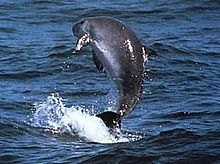
Back حوت العنبر القزم Arabic حوت العنبر القزم ARZ Odayol (Kogia sima) AVK Kiçik cırtdan kaşalot Azerbaijani Кашалот джудже Bulgarian C'hwezher bitous Breton Catxalot nan Catalan Kogia sima CEB Kleiner Pottwal German Kogia sima Spanish
| Dwarf sperm whale[1] Temporal range: [2]
| |
|---|---|

| |

| |
| Size compared to an average human | |
| Scientific classification | |
| Domain: | Eukaryota |
| Kingdom: | Animalia |
| Phylum: | Chordata |
| Class: | Mammalia |
| Order: | Artiodactyla |
| Infraorder: | Cetacea |
| Family: | Kogiidae |
| Genus: | Kogia |
| Species: | K. sima
|
| Binomial name | |
| Kogia sima | |

| |
| Dwarf sperm whale range | |
| Synonyms[5] | |
The dwarf sperm whale (Kogia sima) is a sperm whale that inhabits temperate and tropical oceans worldwide, in particular continental shelves and slopes. It was first described by biologist Richard Owen in 1866, based on illustrations by naturalist Sir Walter Elliot. The species was considered to be synonymous with the pygmy sperm whale (Kogia breviceps) from 1878 until 1998. The dwarf sperm whale is a small whale, 2 to 2.7 m (6 ft 7 in to 8 ft 10 in) and 136 to 272 kg (300 to 600 lb), that has a grey coloration, square head, small jaw, and robust body. Its appearance is very similar to the pygmy sperm whale, distinguished mainly by the position of the dorsal fin on the body–nearer the middle in the dwarf sperm whale and nearer the tail in the other.
The dwarf sperm whale is a suction feeder that mainly eats squid, and does this in small pods of typically one to four members. It is preyed upon by the killer whale (Orcinus orca) and large sharks such as the great white shark (Carcharodon carcharius). When startled, the whale can eject a cloud of red-brown fluid. Most of what is known of the whale comes from beached individuals, as sightings in the ocean are rare. Many of these stranded whales died from parasitic infestations or heart failure.
The dwarf sperm whale is hunted in small numbers around Asia. It is most threatened by ingesting, or getting entangled by marine debris. No global population estimate has been made, and so its conservation status by the International Union for Conservation of Nature (IUCN) is least concern.
- ^ Mead, J. G.; Brownell, R. L. Jr. (2005). "Order Cetacea". In Wilson, D. E.; Reeder, D. M. (eds.). Mammal Species of the World: A Taxonomic and Geographic Reference (3rd ed.). Johns Hopkins University Press. p. 737. ISBN 978-0-8018-8221-0. OCLC 62265494.
- ^ "Kogia sima". Fossilworks. Gateway to the Paleobiology Database. Retrieved 8 March 2024.
- ^ a b Kiszka, J.; Braulik, G. (2020). "Kogia sima". IUCN Red List of Threatened Species. 2020: e.T11048A50359330. doi:10.2305/IUCN.UK.2020-2.RLTS.T11048A50359330.en. Retrieved 19 November 2021.
- ^ "Appendices | CITES". cites.org. Retrieved 2022-01-14.
- ^ Cite error: The named reference
wormswas invoked but never defined (see the help page).
© MMXXIII Rich X Search. We shall prevail. All rights reserved. Rich X Search
